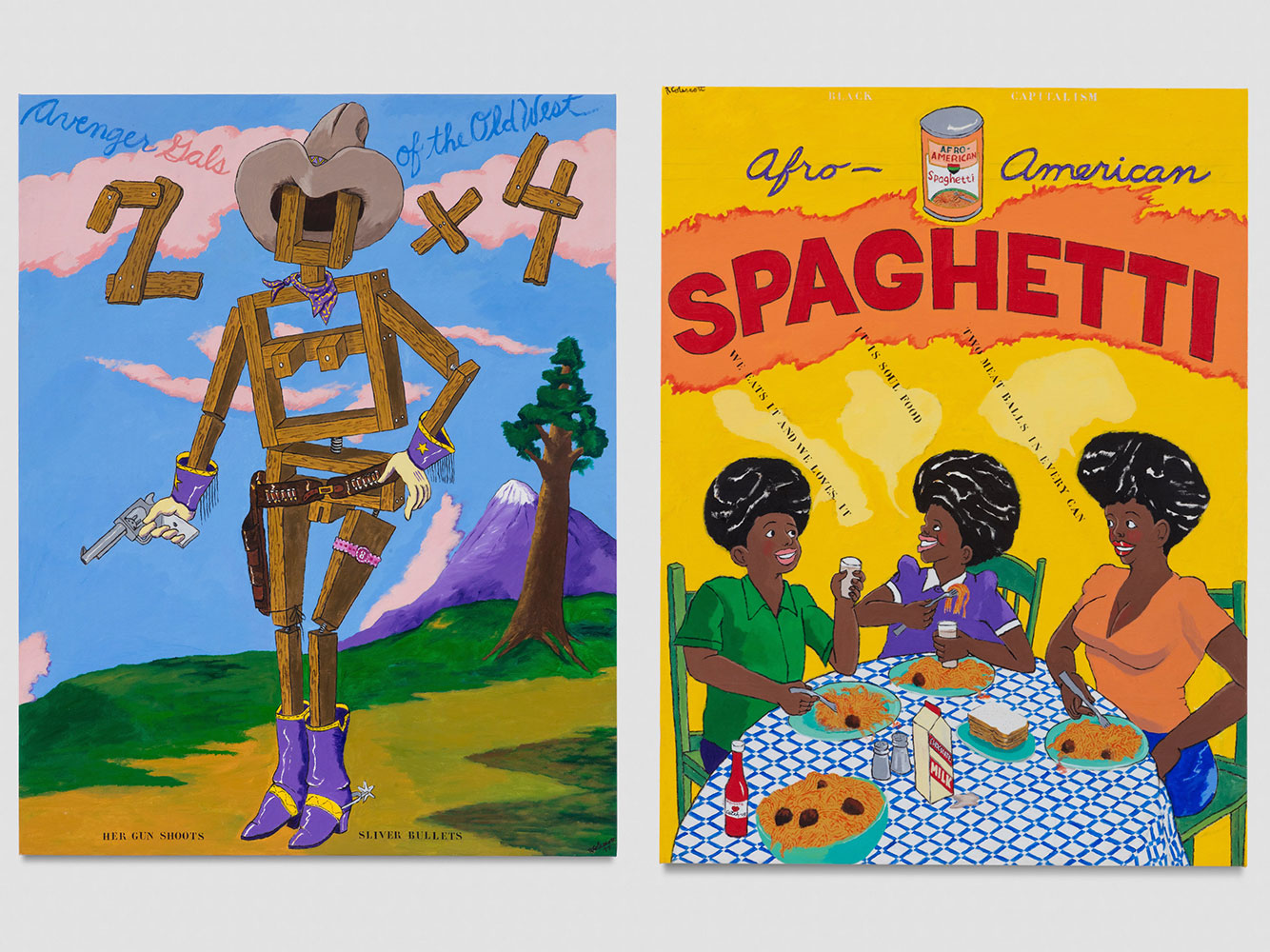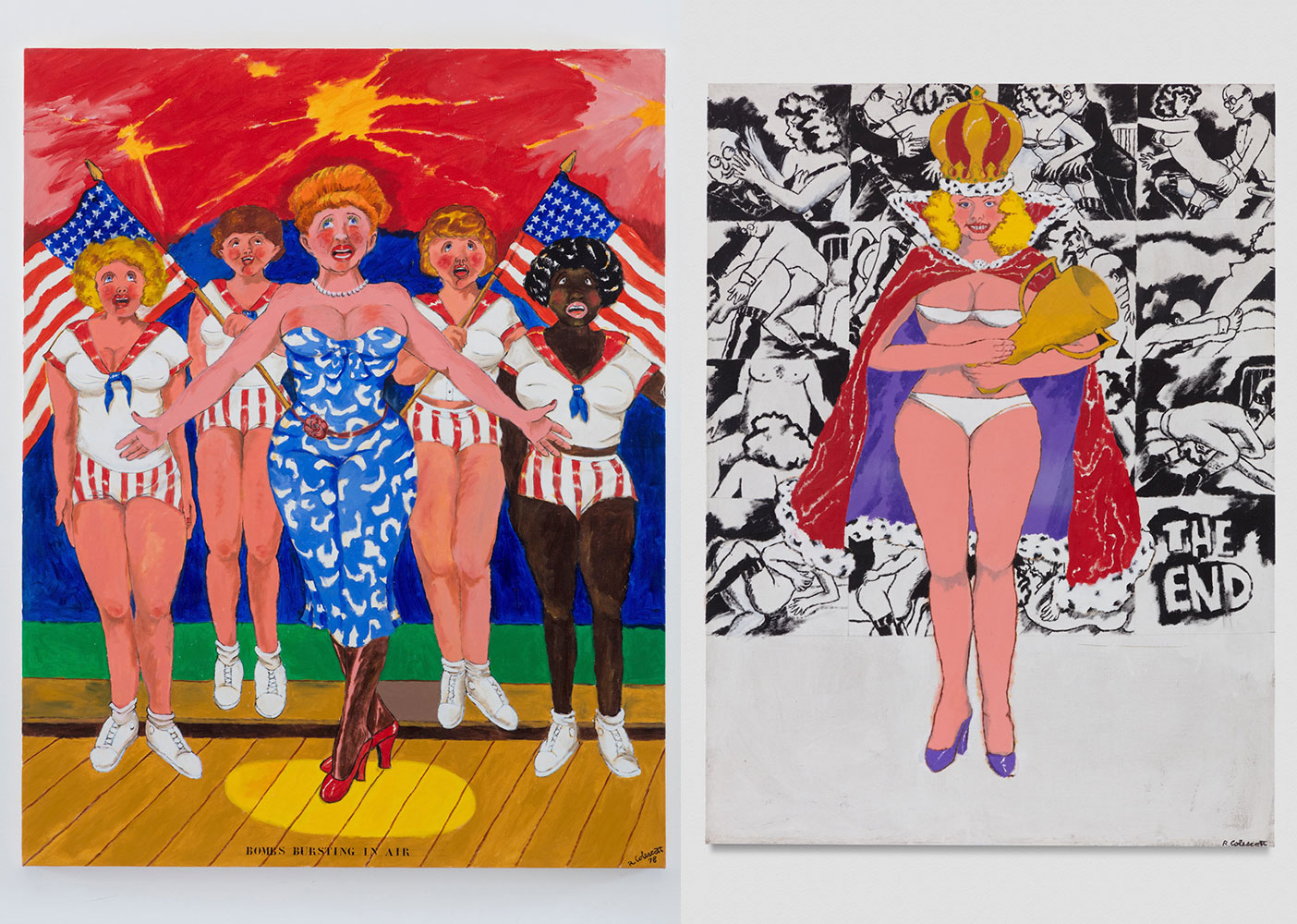PRESENTATION: Robert Colescott-Women
 Over a nearly six-decade career, Robert Colescott was an instigator who fearlessly tackled subjects of social and racial inequality, class structure, and the human condition through his uniquely rhythmic and often manic style of figuration. Colescott’s distinctive works, while not easily placed within any one specific school of painting, share elements of Abstract Expressionism, Pop Art, “Bad” Painting, Renaissance Painting, Neo-Expressionism, and Surrealism.
Over a nearly six-decade career, Robert Colescott was an instigator who fearlessly tackled subjects of social and racial inequality, class structure, and the human condition through his uniquely rhythmic and often manic style of figuration. Colescott’s distinctive works, while not easily placed within any one specific school of painting, share elements of Abstract Expressionism, Pop Art, “Bad” Painting, Renaissance Painting, Neo-Expressionism, and Surrealism.
By Dimitris Lempesis
Photo: Venus Over Manhattan Archive
The exhibition “Women”, is organized to trace the development of Robert Colescott’s depictions of female subjects over the course of his sixty-year career. Serving as a coda to the recent, critically-lauded traveling museum retrospective “Art and Race Matters: The Career of Robert Colescott”, this presentation charts the evolution of Colescott’s ambitious practice through some thirty works produced between 1955 and 1996. Populated by a cast of racist and misogynist caricatures, these blunt appropriations enlist the artist’s signature blend of confrontational humor, startling subject matter, and vivid color to undermine widely held cultural assumptions about history, race, and gender. These bawdy, troublesome works date from the middle of Colescott’s career but their concerns, and the painful stereotypes they employed to address them, were hardly new to his practice. A light-skinned Black man raised to pass for white (and whose brother identified as white), Colescott made work that often exploited racist and sexist imagery to address his “perception of himself as a Black male and an artist in America”.
Robert H. Colescott was born in New Orleans, Louisiana developed a deep love of music early on. His mother was a pianist, and his father was an accomplished classical and jazz violinist. They moved from New Orleans to Oakland, California in 1925. He took up drumming at an early age and seriously considered pursuing a career as a musician before settling instead on art. The sculptor Sargent Claude Johnson was a family friend who was a role model to Colescott growing up and was also a connection to the Harlem Renaissance and artwork dealing with African American experience. In 1940, Colescott watched as the Mexican muralist Diego Rivera painted a mural at the Golden Gate International Exposition on Treasure Island near San Francisco. Colescott went on to absorb the Western art historical canon and to explore the art of Africa and New Guinea. He would always be acutely aware of what was going on in the contemporary art world. Nonetheless, these early experiences remained touchstones. Colescott was drafted into the U.S. Army in 1942 and served in Europe. His tour of duty took him to Paris a city that was hospitable to African American artists. Back home, he enrolled at UC Berkeley, which granted him a bachelor’s degree in drawing and painting in 1949. He spent the following year in Paris, studying with French artist Fernand Léger, then returned to UC Berkeley, earning a master’s degree in 1952. Teaching career Like many artists of his generation, Colescott maintained parallel careers as a committed and influential educator and painter.
He moved to the Pacific Northwest after graduation from UC Berkeley and began teaching at Portland State University. He was on staff there from 1957 to 1966. In 1964 he took a sabbatical with a study grant from the American Research Center in Cairo, Egypt. He returned to Portland for a year but went back to Egypt as a visiting professor at the American University of Cairo from 1966 to 1967. When war broke out, he and his family (moved to Paris for three years. They returned to California in 1970 and he spent the next 15 years painting and teaching art at Cal State, Stanislaus, UC Berkeley, and the San Francisco Art Institute. It was in Portland that Colescott’s professional career as an artist was firmly established, thanks in large part to philanthropist Arlene Schnitzer, owner, and director of the Fountain Gallery, which she opened to promote contemporary artists from the region. Colescott’s work was included in the gallery’s inaugural exhibition in 1961, and he was given his first solo show there in 1963. In a tragic incident in 1977, a fire destroyed the gallery, and many of Colescott’s works burned along with the works of many other artists represented by the gallery. The gallery, which reopened after the fire in a new location, continued to represent Colescott’s work until it closed its doors in 1986. Colescott accepted a position as a visiting professor at the University of Arizona in Tucson in 1983 and joined the faculty in 1985. In 1990 he became the first art department faculty member to be honored with the title of Regents’ Professor.
Colescott’s sojourns in Egypt, and his encounter with Egyptian art and culture and the continent of Africa, were life-changing experiences. The impact on the trajectory of the rest of his artistic career, in terms of both its formal qualities and subject matter, was first manifest in the series of paintings “The Valley of the Queens”, inspired by a visit to Thebes. “Three thousand years or non-European art, a strong narrative tradition, formal qualities such as the fluidity of the graphic line, monumentality of scale, vivid color and sense of pattern–all these elements had a profound, immediate, and lasting impact on his work. retrospective In 1987, the San Jose Museum of Art organized the first major retrospective of Colescott’s work. In 1997 Colescott was “the first African-American artist to represent the United States in a solo exhibition at the Venice Biennale in 1997.” The exhibition was organized by U.S. Commissioner Miriam Roberts and embarked on a three-year tour of museums. The exhibition catalog includes essays by Roberts and Lowery Stokes Sims, a poem by Quincy Troupe, and a photo essay by artist Carrie Mae Weems, to honor Colescott’s influence on a younger generation of artists in general and African American artists in particular. Robert Colescott died June 4, 2009, in Tucson AZ.
Photo: Robert Colescott, Old Crow on the Fence, 1978. Acrylic on canvas; 48 x 66 inces. © The Robert H. Colescott Separate Property Trust / Artists Rights Society (ARS), New York. Courtesy of The Trust and Blum & Poe, Los Angeles/New York/Tokyo, and Venus Over Manhattan, New York
Info: Venus Over Manhattan, 55 Great Jones Street, New York, NY, USA, Duration: 15/11/2022-14/1/2023, Days & Hours: Tue-Sat 10:00-18:00, www.venusovermanhattan.com/


Right: Robert Colescott, Moonlighting in Porno: Sex on the Slope, 1976, Acrylic on canvas with wooden cutout, 91 x 59 1/4 x 1 5/8 inches, © The Robert H. Colescott Separate Property Trust / Artists Rights Society (ARS), New York. Courtesy of The Trust and Blum & Poe, Los Angeles/New York/Tokyo, and Venus Over Manhattan, New York

Right: Robert Colescott, Black Capitalism: Afro American Spaghetti, 1971-1973, Acrylic on canvas, 77 3/4 x 59 x 1 5/8 inches, © The Robert H. Colescott Separate Property Trust / Artists Rights Society (ARS), New York. Courtesy of The Trust and Blum & Poe, Los Angeles/New York/Tokyo, and Venus Over Manhattan, New York

Right: Robert Colescott, American Beauty, 1976, Acrylic on canvas, 78 3/8 x 58 5/8 x 1 5/8 inches, © The Robert H. Colescott Separate Property Trust / Artists Rights Society (ARS), New York. Courtesy of The Trust and Blum & Poe, Los Angeles/New York/Tokyo, and Venus Over Manhattan, New York

Right: Robert Colescott, Cactus Jack, 1977, Acrylic on canvas, 83 1/4 x 64 x 1 5/8 inches, © The Robert H. Colescott Separate Property Trust / Artists Rights Society (ARS), New York. Courtesy of The Trust and Blum & Poe, Los Angeles/New York/Tokyo, and Venus Over Manhattan, New York

Right: Robert Colescott, Black as Satan, 1992. Acrylic on canvas; 84 x 72 inches, © The Robert H. Colescott Separate Property Trust / Artists Rights Society (ARS), New York. Courtesy of The Trust and Blum & Poe, Los Angeles/New York/Tokyo, and Venus Over Manhattan, New York
